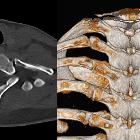Kloakenekstrophie


Cloacal exstrophy (CE) is an extensive congenital abdominal wall defect which encompasses:
Epidemiology
The estimated prevalence is at around 1 in 50,000 to 200,000 live births. There is a recognized male predilection with a M:F ratio of ~2:1.
Pathology
It results from persistence and premature perforation of the cloacal membrane. Cloacal exstrophy is considered to be the most severe end of the spectrum of disease ranging from epispadias at one end to cloacal exstrophy at the other.
Genetics
Most cases are sporadic.
Associations
Recognized wider associations include:
- OEIS complex
- vertebral anomalies
- limb anomalies
- myelomeningocele
- divided or duplicated penis
Markers
Radiographic features
Antenatal ultrasound
A large ventral wall defect may be seen. Some antenatal-postnatal ultrasound findings can overlap with that of bladder exstrophy and include:
- failure to visualize a normal urinary bladder
- pubic diastasis: can difficult to identify in-utero
- presence of a soft-tissue mass protruding from the lower anterior abdominal wall surface
Additional features present with cloacal exstrophy includes:
- presence of an omphalocele
- presence of lumbosacral anomalies
Treatment and prognosis
While not usually lethal, cloacal exstrophy often carries a poor prognosis where a series of operations are often required.
Siehe auch:
- angeborene Wirbelanomalien
- Myelomeningozele
- Blasenekstrophie
- Omphalozele
- epispadias
- OEIS complex
- abdominal wall defect
- congenital abdominal wall defect
- elevated maternal alpha feto protein levels
und weiter:

 Assoziationen und Differentialdiagnosen zu Kloakenekstrophie:
Assoziationen und Differentialdiagnosen zu Kloakenekstrophie:



